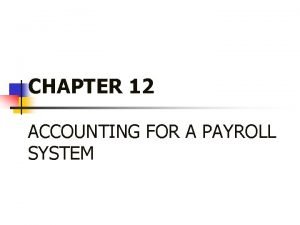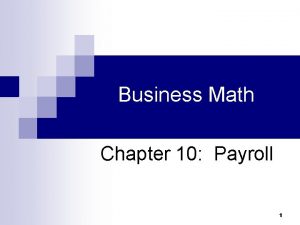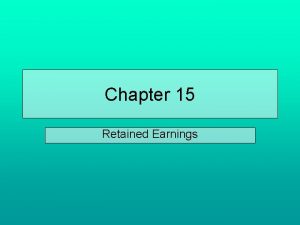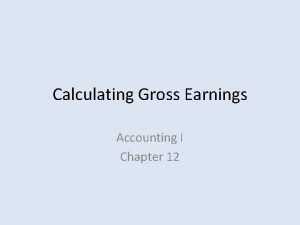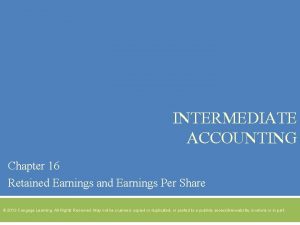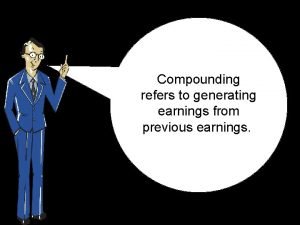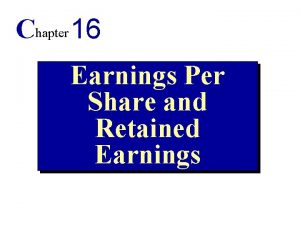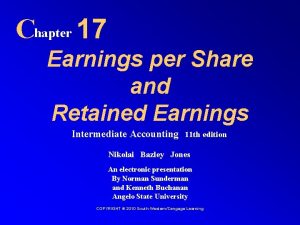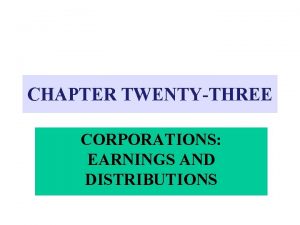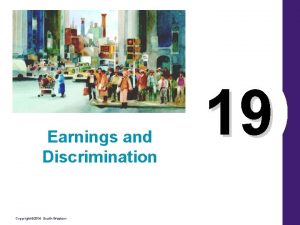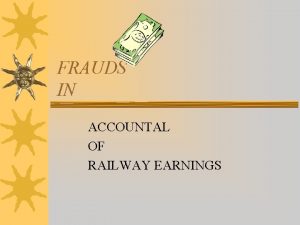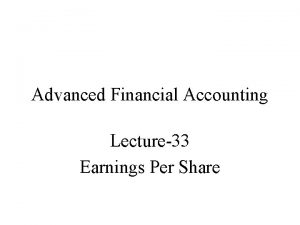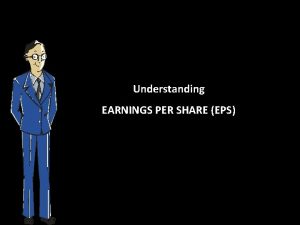Gross earnings is the total amount an employee


































- Slides: 34


Gross earnings is the total amount an employee earns in a pay period. Payroll deductions are amounts withheld from an employee’s gross earnings. Accounting Copyright © by Mc. Graw-Hill Education. All rights reserved.

Using a Payroll System Section 12. 1 Calculating Gross Earnings Payroll The collection and processing of all information needed to prepare and issue payroll checks The generation of payroll records needed for accounting purposes and for reporting to government agencies, management, and others PAYROLL A list of the employees and the payments due to each employee for a specific pay period. Accounting Copyright © by Mc. Graw-Hill Education. All rights reserved.

Computing Gross Pay Section 12. 1 Calculating Gross Earnings GROSS EARNINGS The total amount of money an employee earns in a pay period; also called gross pay. Pay Categories That Help Determine Gross Earnings Salary Hourly Wage Commission Salary plus Commission or Bonus Piece Rate / Piecework Accounting Copyright © by Mc. Graw-Hill Education. All rights reserved.

SALARY A fixed amount of money paid to an employee for each pay period. Glencoe Accounting Copyright © by Mc. Graw-Hill Education. All rights reserved.

Using a Payroll System Section 12. 1 Calculating Gross Earnings Weekly – Paid every week (52/yr) Most Pay Periods Are Either: Biweekly – every other week (26/yr) Semimonthly – 2 x per month (24/yr) Monthly – 1 x per month (12/yr) PAY PERIOD The amount of time over which an employee is paid. Accounting Copyright © by Mc. Graw-Hill Education. All rights reserved.

Question 1 Accounting Glencoe Copyright © by Mc. Graw-Hill Education. All rights reserved.

Question 2 Accounting Glencoe Copyright © by Mc. Graw-Hill Education. All rights reserved.

Question 3 If the annual salary is $42, 900, what is the biweekly salary? Accounting Glencoe Copyright © by Mc. Graw-Hill Education. All rights reserved.

Question 4 If the annual salary is $18, 200, what is the semimonthly salary? Accounting Glencoe Copyright © by Mc. Graw-Hill Education. All rights reserved.

Using a Payroll System Section 12. 1 Calculating Gross Earnings PAYROLL CLERK An employee responsible for preparing the payroll. Responsibilities of a Payroll Clerk Makes sure employees are paid on time Makes sure each employee is paid the correct amount Completes payroll records Submits payroll reports Pays payroll taxes Accounting Copyright © by Mc. Graw-Hill Education. All rights reserved.

Computing Gross Pay Section 12. 1 Calculating Gross Earnings HOURLY WAGE An amount of money paid to an employee at a specified rate per hour worked. Accounting Copyright © by Mc. Graw-Hill Education. All rights reserved.

Computing Gross Pay Section 12. 1 Calculating Gross Earnings The overtime rate was set by the Fair Labor Standards Act of 1938. OVERTIME RATE Pay rate employers are required to pay certain employees covered by state and federal laws; the Fair Labor Standards Act of 1938 sets the rate at 1. 5 times the regular hourly rate after 40 hours per week. Accounting Copyright © by Mc. Graw-Hill Education. All rights reserved.

Computing Gross Pay Section 12. 1 Calculating Gross Earnings Sales employees are often paid a commission. Some sales employees are paid salary plus commission. COMMISSION An amount paid to an employee based on a percentage of the employee’s sales. Accounting Copyright © by Mc. Graw-Hill Education. All rights reserved.

SALARY PLUS COMMISSION Earn a guaranteed base salary amount plus an unidentified amount of commission based on sales COMMISSION = Net Sales x Commission Rate Glencoe Accounting Copyright © by Mc. Graw-Hill Education. All rights reserved.

PIECE RATE A rate of pay based on the number of items produced. Accounting Copyright © by Mc. Graw-Hill Education. All rights reserved.

Section 12. 2 Payroll Deductions Key Terms deduction withholding allowance 401 (k) plan Accounting Copyright © by Mc. Graw-Hill Education. All rights reserved.

Deductions Required by Law Section 12. 2 Payroll Deductions Required by Law Federal Income Tax Social Security Tax City and State Income Tax DEDUCTION An amount that is subtracted from an employee’s gross earnings. Accounting Copyright © by Mc. Graw-Hill Education. All rights reserved.

Deductions Required by Law Section 12. 2 Payroll Deductions What Is a withholding allowance? WITHHOLDING ALLOWANCE An allowance an individual claims on a Form W-4; it is used to calculate the amount of income tax withheld from an employee’s paycheck. Accounting Copyright © by Mc. Graw-Hill Education. All rights reserved.

Deductions Required by Law Section 12. 2 Payroll Deductions Too much money withheld Employer withholds federal income tax Too little money withheld Accounting Refund from the IRS Amount Due to the IRS Copyright © by Mc. Graw-Hill Education. All rights reserved.

Deductions Required by Law Section 12. 2 Payroll Deductions The employee’s marital status (found on Form W-4) The amount of income tax withheld depends on: Number of allowances claimed (found on Form W-4) The employee’s gross earnings Accounting Copyright © by Mc. Graw-Hill Education. All rights reserved.

Deductions Required by Law Section 12. 2 Accounting Payroll Deductions See page 319 Copyright © by Mc. Graw-Hill Education. All rights reserved.

Deductions Required by Law Section 12. 2 Payroll Deductions The Federal Insurance Contributions Act (FICA) established social security taxes in 1935. Two components of FICA are: Social security–provided as old age and disability insurance and survivors’ benefits Accounting Medicare–provides health insurance for people who are elderly or disabled Copyright © by Mc. Graw-Hill Education. All rights reserved.

Voluntary Deductions Section 12. 2 Payroll Deductions Examples of Voluntary Deductions Union Dues Health Insurance Payments Life Insurance Payments U. S. Savings Bonds Charitable Contributions Pensions Credit Union Deposits and Payments Accounting Copyright © by Mc. Graw-Hill Education. All rights reserved.

Voluntary Deductions Section 12. 2 Payroll Deductions The 401(k) plan is a popular voluntary payroll deduction. 401(k) PLAN A voluntary payroll deduction from gross earnings; the employee does not pay income tax on the amount contributed until the money is withdrawn from the plan, usually after age 59½. Accounting Copyright © by Mc. Graw-Hill Education. All rights reserved.

Section 12. 3 Payroll Records Key Terms payroll register net pay direct deposit employee’s earnings record accumulated earnings Accounting Copyright © by Mc. Graw-Hill Education. All rights reserved.

Preparing the Payroll Register Section 12. 3 Payroll Records Seven Parts of the Payroll Register 1. Total Hours Column 2. Rate Column payroll register A form that summarizes information about employees’ earnings for each pay period. 3. Earnings Section 4. Deductions Section 5. Net Pay Column 6. Check Number Column 7. Column Totals Accounting net pay The amount left after total deductions have been subtracted from gross earnings. Copyright © by Mc. Graw-Hill Education. All rights reserved.

Preparing the Payroll Register Section 12. 3 Payroll Records See page 323 1. Total Hours Column 5. Net Pay Column 2. Rate Column 6. Check Number Column 3. Earnings Section 7. Column Totals 4. Deductions Section Accounting Copyright © by Mc. Graw-Hill Education. All rights reserved.

Paying Employees Section 12. 3 Payroll Records Check Methods of Paying Employees Direct Deposit direct deposit Depositing net pay directly into an employee’s personal bank account through electronic funds transfer. Accounting Copyright © by Mc. Graw-Hill Education. All rights reserved.

The Employee’s Earnings Record Section 12. 3 Payroll Records An employer must also keep an employee’s earning record, which includes accumulated earnings information. employee’s earning record A record prepared for each employee that contains all payroll information related to the employee; it is kept on a quarterly basis. accumulated earnings The employee’s year-to-date gross earnings. Accounting Copyright © by Mc. Graw-Hill Education. All rights reserved.

Managerial Implications for Payroll Accounting Section 12. 3 Payroll Records How Payroll Information Can Be Used To determine if overtime is justified. To compare actual amounts to budgeted amounts to reveal unplanned overtime. Accounting Copyright © by Mc. Graw-Hill Education. All rights reserved.

Question 1 Wayne Hanson is paid $9 per hour. He worked 44 hours last week. In addition, he receives time and one-half for overtime. Calculate his gross pay for the week. Step 1: Multiply his regular pay by the number of hours worked ($9. 00 x 40 = $360. 00). Step 2: Calculate the overtime rate by multiplying the regular hourly wage by 1. 5 ($9. 00 x 1. 5 = $13. 50). Step 3: Multiply the number of overtime hours by the overtime rate (44 - 40 = 4 hours of overtime; 4 x $13. 50 = $54. 00). Step 4: Add the regular pay and the overtime pay ($360. 00 + $54. 00 = $414. 00). Accounting Copyright © by Mc. Graw-Hill Education. All rights reserved.

Question 2 What are at least three pieces of information you can learn from your weekly payroll check? Among the important facts you can find from your weekly payroll check are these: 1. The time period in which the work was 6. Amount of social security tax performed. withheld. 2. The total number of regular hours. 7. Amount of federal income tax withheld. 3. The total number of overtime hours. 8. Amount of state income tax withheld. 4. Total gross pay. 9. Any voluntary deductions withheld. 5. Amount of Medicare tax withheld. 10. Total net pay. Accounting Copyright © by Mc. Graw-Hill Education. All rights reserved.

End of
 The total amount of an employee's earnings is called
The total amount of an employee's earnings is called Cara menghitung insurable value dengan gross earning form
Cara menghitung insurable value dengan gross earning form 12-1 calculating gross earnings
12-1 calculating gross earnings Gross earnings formula business math
Gross earnings formula business math Menghitung insurable value dengan gross earning form
Menghitung insurable value dengan gross earning form Npv adalah
Npv adalah Employee attitudes and employee performance
Employee attitudes and employee performance Energy pyramid biomass
Energy pyramid biomass Total revenues minus total costs equals
Total revenues minus total costs equals Unidad 3 razones financieras
Unidad 3 razones financieras Total revenue minus total expenses
Total revenue minus total expenses Total revenues minus total costs equals
Total revenues minus total costs equals Total revenues minus total costs equals
Total revenues minus total costs equals Bài hát chúa yêu trần thế alleluia
Bài hát chúa yêu trần thế alleluia Sự nuôi và dạy con của hổ
Sự nuôi và dạy con của hổ đại từ thay thế
đại từ thay thế Vẽ hình chiếu vuông góc của vật thể sau
Vẽ hình chiếu vuông góc của vật thể sau Công thức tính thế năng
Công thức tính thế năng Tỉ lệ cơ thể trẻ em
Tỉ lệ cơ thể trẻ em Thế nào là mạng điện lắp đặt kiểu nổi
Thế nào là mạng điện lắp đặt kiểu nổi Lời thề hippocrates
Lời thề hippocrates Các loại đột biến cấu trúc nhiễm sắc thể
Các loại đột biến cấu trúc nhiễm sắc thể Vẽ hình chiếu đứng bằng cạnh của vật thể
Vẽ hình chiếu đứng bằng cạnh của vật thể Quá trình desamine hóa có thể tạo ra
Quá trình desamine hóa có thể tạo ra độ dài liên kết
độ dài liên kết Các môn thể thao bắt đầu bằng từ đua
Các môn thể thao bắt đầu bằng từ đua Khi nào hổ mẹ dạy hổ con săn mồi
Khi nào hổ mẹ dạy hổ con săn mồi điện thế nghỉ
điện thế nghỉ Thế nào là sự mỏi cơ
Thế nào là sự mỏi cơ Trời xanh đây là của chúng ta thể thơ
Trời xanh đây là của chúng ta thể thơ Voi kéo gỗ như thế nào
Voi kéo gỗ như thế nào Thiếu nhi thế giới liên hoan
Thiếu nhi thế giới liên hoan Phối cảnh
Phối cảnh Một số thể thơ truyền thống
Một số thể thơ truyền thống Các châu lục và đại dương trên thế giới
Các châu lục và đại dương trên thế giới


